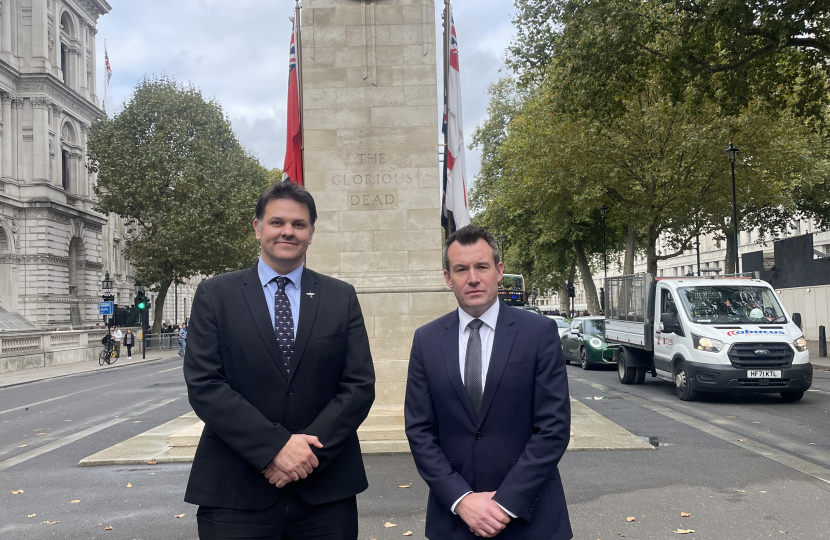
Stuart Anderson MP Backs Campaign to Honour Churchill's 'Eyes in the Sky' From Shropshire
Stuart Anderson MP is proudly backing a campaign to commemorate Britain's brave pilots, navigators, and observers who served as Churchill’s eyes in the sky during the Second World War. Formed on 24th September 1939, the Photographic Reconnaissance Unit (PRU) was an unarmed branch of the Royal Air Force (RAF) that provided up-to-date intelligence on enemy activity - enabling Britain's leaders to plan major operations from D-Day to the Dambuster's Raid. Stuart is raising awareness of their heroic efforts, with two men from Shropshire having served in PRUs, where they took photographs in important aerial reconnaissance missions.
Flying Spitfires and Mosquitos, those serving in PRUs captured more than 26 million images of enemy operations and installations during the War. Denis Parry and Lionel Scargill, both from Shropshire, played a critical role in doing so. To carry as much fuel as possible, their planes were stripped of guns. They flew in highly dangerous, clandestine operations, gathering visual insights. These were handed to Photographic Interpreters (PIs) before being passed on to Britain's leaders who planned the war response from the Cabinet War Rooms in London, now known as the ‘Churchill War Rooms’, located underneath HM Treasury in Whitehall. By 1945, PRUs were taking up to 50,000 images per day. They also monitored movements made by battleships like Bismarck and its sister, the Tirpitz. PRUs also located German military installations such as the V1 and V2 rocket launching sites at Peenemünde.
Due to the unprotected nature of their work, the death rate for those serving in PRUs was tragically 48% - resulting in one of the lowest survival rates. Life expectancy stood at around just two and a half months. Of the 1,287 men who flew in the PRU, 378 were killed and 143 of them have no known grave. To honour their sacrifices, Stuart is backing the ‘Spitfire AA810 Project’, which has been launched with the aim of ultimately establishing a memorial in central London. The project also hopes to rebuild, and return to flight, the eponymous Spitfire AA810, which was shot down during a mission to photograph Tirpitz in March 1942. It was found in a peat bog in Norway in June 2018 by engineer and founder of the project, Tony Hoskins, after years of research. Having met with the Cabinet Office and Westminster Council in Spring 2024, fundraising is underway for the planning application to be made.
Alongside this, the project runs a STEM-focused education programme - the Schools Aerospace Careers Programme (SACP). This inspires school-aged pupils to pursue careers in aerospace, aviation, and motorsports through either apprenticeships or graduate level qualifications. Last year, the project engaged with just under 776,000 secondary and further education pupils. Stuart has endorsed their work to build recruitment pools for these sectors, which he says has great potential to unlock rural prosperity.
By the time of the General Election, the project had grown a parliamentary caucus of more than 200 supporters. As a result of changes, this has dropped to 104 due to changes following the General Election. Stuart is encouraged that work is ongoing to engage with newly elected MPs in constituencies that are linked to those that will be commemorated by the Monument. Stuart has called on the Secretary of State for Defence, the Rt. Hon. John Healey MP, to support and engage with leaders as plans are progressed.
Stuart Anderson said:
“Known as Churchill's eyes in the sky, Britain's brave pilots, navigators, and observers who served in the Photographic Reconnaissance Unit provided invaluable visual insights that gave us a strong strategic advantage during the Second World War and paved the way for victory in Europe. Pioneered by the Royal Air Force, photographic reconnaissance was an integral tool in planning major operations from D-Day to the Dambusters Raid. Despite having a 48% death rate, PRU's heroic efforts have gone largely unnoticed - until now. The Spitfire AA810 Project is shining a much-needed spotlight on these unsung heroes, including Denis Parry and Lionel Scargill from Shropshire, who served admirably under exceptionally difficult conditions - with both tragically losing their lives while serving their country. As a veteran myself, I am proud to become a parliamentary supporter of this incredible campaign, which has been launched with the aim of ultimately establishing a national monument in memory of them. As we mark the season of remembrance, I urge everyone to find out more about the campaign. I look forward to visiting the Monument once it is complete.”
Denis Parry
Flight Sergeant Denis Albert Edward Parry was born in Atcham, Shropshire in May 1922. He joined the RAF and trained as a navigator. Joining 544 Photographic Reconnaissance Squadron, he started flying Mosquitos across occupied territory. At 0930 on 14th September 1944, he took off from RAF Benson intending to photograph targets in Poland before ultimately crossing the Alps to land in Italy. He and his pilot F/Lt Eric Jones were attacked and shot down by Messerschmitt fighters. While Denis Parry was able to extract himself and descend by parachute, Eric Jones went down with the aircraft. Parry was captured shortly after and spent the rest of the war in Stalag Luft 7, where he was liberated and returned to the UK in 1945. He married Ruby Bevan in 1950 and moved to Shrewsbury where he had two children. Sadly, he died in November 1969 aged just 47.
Lionel Scargill
Flight Lieutenant Lionel Hamilton Scargill was born in Cleobury Mortimer in 1914. Little is known of his pre-war life except that he was a school master when he enlisted in 1941 before he trained as a pilot. He was posted eventually to 541 Photographic Reconnaissance Squadron flying unarmed Spitfires, a task he continued throughout the war until he was shot down in a Spitfire PR.XIX in March 1945. He was taken prisoner for a short while but with VE Day he returned to the UK and began a life of flight-testing new bombing equipment, including the ‘Highball’ bomb for use against Japanese shipping. After the end of the war, he stayed in the military before transferring to Airwork, a civilian contractor carrying out tasks for the military. He was killed in a flying accident in November 1957 when he was involved in a mid-air collision flying a Fairey Firefly on target towing duties.
More Information
More information on the ‘Spitfire AA810 Project’, the history, the plane and its pilots, and the Memorial campaign can be found at www.spitfireaa810.co.uk. As there is no complete listing of those who served in PRUs, the project is keen to reach out to families to collect their stories, so that their loved ones will once again be more than just another name carved on a war memorial.
If you are related to Denis Parry or Lionel Scargill, or if you know anyone who served in PRUs during the War, please contact Stuart Anderson MP or get in touch with the Spitfire AA810 Project leader directly, Mr Tony Hoskins ([email protected]).




